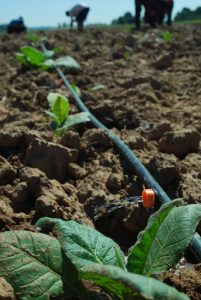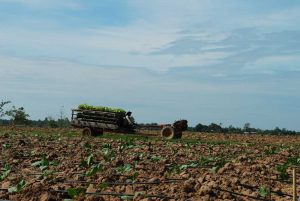Growing and harvesting tobacco crops can be a remarkably uncomplicated process.
Once farmers plant tobacco plants they need to water them regularly, and when harvest season arrives, they start picking the ripe leaves.
 Starting at the bottom, where leaves mature the earliest, they work their way to the top as the season progresses, ending with the most valuable top leaves.
Starting at the bottom, where leaves mature the earliest, they work their way to the top as the season progresses, ending with the most valuable top leaves.
Most tobacco farmers plant and harvest in the rainy season, when plants have the best chance of receiving enough water throughout the season. But in Laos, where the monsoons make the ground too wet for planting, planting and harvesting is carried out in the dry season.
Farmers therefore have to water the plants by hand, one-by-one, a process that takes three to four days a week. This will take a back seat at harvesting time, when the farmer will focus on reaping the ripe leaves.
As a result, the plant will often not get enough water after harvesting has started. By the end of the harvest, the high-value leaves at the top of the plant will see the overall quality and yield suffer.
Tobacco farmers only have one chance a year to take their crop to market; If the crop is no good, a year is a long time to wait for the next chance to earn some money.
 It’s a singular problem for tobacco farmers, especially those still using manual watering systems like in Laos. But Lao Tobacco is piloting a new irrigation program to solve what is technically a simple problem of timing.
It’s a singular problem for tobacco farmers, especially those still using manual watering systems like in Laos. But Lao Tobacco is piloting a new irrigation program to solve what is technically a simple problem of timing.
In a pilot scheme this year, the company is providing around 30 farmers with a new automatic irrigation system, that brings water automatically to the crop via pipelines.
Mark Ballance, Lao Tobacco’s Leaf Growing and Blending Manager, says the system will reduce the amount of labour required for a crop quite substantially.
“It will reduce water consumption and improve yields, so from a technical point of view it’s very beneficial,” he says.
 “But, just as important for the farmers, it will reduce the amount of time spent watering the crop from several days a week, to just half a day a week.”
“But, just as important for the farmers, it will reduce the amount of time spent watering the crop from several days a week, to just half a day a week.”
This will also prevent the leaves at the top of the plant from becoming, in Ballance’s words, “droughty”, or too dry to be properly cured.
The system will be trialled on just half a crop per farmer, to enable to company to collect data on the difference in water consumption, but it’s clear that the amount of labour required will be reduced to allow the farmer more time to carry out other activities, such as harvesting the crop.
Ballance says the company’s intention is to demonstrate the initial success of the system, and encourage farmers over time to invest in the systems themselves, to save time, water and money in the long run.



 ລາວ
ລາວ
